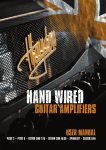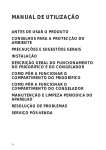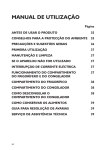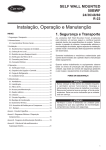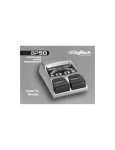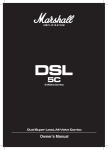Download GUITAR AMPLIFIERS
Transcript
MoFo GUITAR AMPLIFIERS USER MANUAL MOFO • MINI MOFO USER MANUAL MOFO • MINI MOFO WELCOME TO HAYDEN GUITAR AMPLIFICATION Thank you for choosing a Hayden MoFo guitar amplifier. To ensure that you receive the full benefits of the Hayden warranty, please register your amplifier at www.haydenamps.com WARRANTY Your amplifier is covered by a one year warranty, against defects in materials and workmanship, for the original purchaser. Hayden will, at their discretion, replace or repair any product or part thereof, which is found by Hayden to be defective. This warranty shall not apply to the damage of covering, fittings or finishes when affected by carelessness, accident or extreme climate changes. Nor does it apply to normal wear and tear of parts such as valves, fuses, light bulbs, speakers, controls etc. In the unlikely event of any defect, please contact an authorised Hayden dealer. All transport charges are to be pre-paid by the Owner. Unless your purchase is registered on-line, normal country warranty laws apply. DESIGN AND BUILD PHILOSOPHY The MoFo by Hayden is an all-valve guitar amp with a whole lot of attitude. But unlike other mini guitar amp heads, the MoFo is definitely not a one trick pony. From stunning bell like clean tones with real depth to plexiesque classic rock crunch, right up to full on metal mayhem, the 30 watt MoFo head does it all. With four cascaded gain stages and a footswitchable MoFo mode for even more gain, the MoFo’s do it all from classic clean tones through plexi-esque classic rock crunch to full metal mayhem. And the versatility doesn’t stop with the sounds. With both 8 and 16 Ohm speaker outputs, the MoFo’s can drive a wide range of cabinets from a boutique 1x12 in the studio right up to a 4x12 on the concert stage. Separate UK and US-voiced instrument inputs shape the signal for classic British or thicker, higher-gain US tones respectively, and a simple series FX loop allows you connect your favourite stomp boxes. And when you’re rehearsing, you’ll love the Stealth switch underneath the amp which lets your MoFo scream, without the neighbours screaming at you. KEY FEATURES • MoFo - 30 Watts from 4 x EL84 valves • Mini MoFo - 15 Watts from 2 x EL84 valves • Single channel with footswitchable MoFo mode for more gain (footswitch included with MoFo, optional with Mini MoFo) • Stealth switch reduces overall volume for practice use • 4 cascaded gain stages for classic clean tones through to full metal mayhem • 8/16 Ohm speaker outputs for a variety of cabinet options • Bass, middle, treble and presence controls • Separate US and UK-voiced guitar inputs • Series effects loop • Rugged steel chassis • Comes in a padded gigbag with shoulder strap • Designed and engineered in the UK HAND WIRED GUITAR AMPLIFIERS IMPORTANT SAFETY INSTRUCTIONS This Hayden amplifier has been designed to provide you with many years of faithful service – on the road, in a studio or in a domestic environment. By following the rules set out below, you will ensure that the unit functions safely. Valve (tube) instrument amplifiers contain very high voltages and fragile glass tubes and should therefore be handled with care. A number of important precautions which must be observed are set out below. Before using the amplifier, run through the check list below. If you are in any doubt about any aspect of the amplifier’s operation, stop using it immediately and do not resume operation until the amplifier has been thoroughly inspected by a qualified technician. 1) Storage and moving When your amplifier is not in use make sure that the power cord is unplugged from the mains outlet, and that all leads are removed from the amplifier, including jack leads and footswitch leads. Jack socket connectors are self-cleaning, so the process of plugging in and unplugging the leads when not in use will ensure that the internal contacts will be cleaned when you plug in again. Store your amplifier in a warm, dry place away from moisture and condensation. A motor vehicle or cellar may look dry but condensation can form inside the unit causing short circuits and possible electric shock. If you suspect the amplifier may have become exposed to moisture, move it to a warm dry place and leave it to dry out for at least 48 hours before attempting to use it. Condensation can also occur when you move the amplifier from a hot humid place (such as a nightclub) to a cold place (like a motor vehicle). In such instances, always move the amplifier into a warm dry room to prevent damage. When moving the amplifier, handle it as carefully as you would your instruments. Although solidly built, an amplifier is easily damaged by shock, so be careful not to drop it or allow it to fall over. Use a protective cover to protect the finish and, if you are transporting it with other equipment, make sure that the amplifier is on a solid floor at the bottom of the pile. When returning your MoFo to its gigbag, always ensure that the control knobs are facing upwards, ie that the amplifier rests on its back panel when in the gigbag. Amplifiers are heavy. Take care when lifting, always use the handles fitted to the amplifier to move it, and get help if you have to lift the amplifier to a greater height than you feel comfortable with. Never attempt to operate the amplifier after it has been dropped. Take it to a qualified technician and have it checked before using it again. 2) Leads and plugs Your amplifier contains possibly lethal voltages and must therefore be connected to the mains using the correct power cord, which is a three terminal type with a ground connection. The power cord supplied with the unit should be of the correct type. If it does not fit your mains outlet consult your dealer or a qualified electrician for advice before attempting to use the amplifier. Never modify the power cord or attempt to use it with a two pin outlet. Store all your leads in a dry case and take care when packing them away. All leads, including guitar leads, are easily damaged with careless handling, so it is a good idea to carry a spare lead of every type you use. Flexible power cords get damaged very easily. At the first sign of damage, discard it and purchase a new one. Always replace the power cord with one of the same type. Moulded cords are the best choice with both plugs permanently fitted to the cord. When using your amplifier and other equipment it is a good idea to connect to the supply using a unit known as an R.C.D. These units are not expensive and offer the user additional protection against electric shock. An electrical shop should be able to supply you with a suitable unit. USER MANUAL MOFO • MINI MOFO IMPORTANT SAFETY INSTRUCTIONS - CONTINUED 3) Before Use Inspect your amplifier for damage before use. Check each lead for damage before you plug them in to the amplifier, and ensure that the loudspeaker is connected before you switch the amplifier on. Never try to operate the amplifier without the speaker connected. If you do, serious damage to the amplifier will result which will be very expensive to repair. Double check the connections you have made to your amplifier and make sure you have connected the speaker to the correct outlet socket that matches the cabinet you are using. The impedance of the speaker is important and is usually shown on a plate affixed to the back of the cabinet, so if the cabinet is 16R (Ohms) then you plug into the 16R outlet on the amplifier. (See additional notes on this subject later in the manual). 4) Using the amplifier When you set the amplifier up for use, it is important that you adhere to the following rules: Place the amplifier away from sources of heat, including radiators, etc. The amplifier itself will get hot in normal use. Make sure that all the grilles on the amplifier are not obstructed in any way so that cooling air can circulate through the amplifier. Do not place anything on or behind the amplifier that might restrict the flow of air. This includes items of clothing, or other equipment. Do not place the amplifier in such a position where it may get splashed with liquid or water, e.g. near tables of drinks or near equipment that contains water, e.g. smoke and bubble machines Never stand bottles or containers of liquid on the amplifier. If any liquid is accidentally spilled into the amplifier, unplug it from the mains supply immediately and take the amplifier to a qualified technician for inspection. Do not place objects on the amplifier that could fall inside and cause a malfunction, e.g. coins, tools, etc. 5) Sound level The level of sound or ‘volume’ you choose to use will mainly be dependant on the size of the room you are playing in and you should use the volume level that gives you the desired results. Always operate the amplifier at the lowest level you can in any given situation. Each room will have a sweet spot. Play at too low a level and the instrument will not react with the amplifier, too high and the instrument will be unplayable. In all cases you should use a level that you feel comfortable with. The Human ear is a very sensitive instrument and can easily be permanently damaged by exposure to the high sound pressure levels that can be produced by this type of amplifier. Do not operate for prolonged periods of time at high volume without suitable ear protection, or at a level that causes you discomfort in any way. If you experience any hearing loss or ringing in the ears you should consult a doctor or audiologist. 6) Fuses and ratings Your amplifier is fitted with several fuses to protect yourself and the expensive electronics inside from damage in the event of a malfunction within the amplifier. The size and rating of the fuses bas been calculated to offer the most protection from damage possible. Various circumstances can lead to fuse failure. It is recommended that you familiarise yourself with the type and rating of the individual fuses fitted to your amplifier and carry spare fuses clearly marked with you as replacements. Occasionally a fuse will fail as a result of a power surge in the supply or as a result of incorrect connection of the loudspeaker. It is permissible to replace the damaged fuse with one of the same type and rating as stated on the rear panel of the amplifier, having first unplugged the amplifier from the mains supply and allowed it to cool down. If the fuse keeps blowing this indicates that there is a more serious fault within the amplifier such as a damaged tube. In this event you must take the amplifier to a qualified technician for repair. Never fit a fuse larger than the recommended rating. The fuses fitted to you amplifier are ‘Anti Surge’ or ‘Slow Blow’ or ‘Time delay’ type fuses, and have the prefix T or H in the part number. So, for example, a 5 Amp fuse would be T 5A H. The exact rating for each particular fuse can be found next to the holder in which that fuse fits. If you are not sure what to buy when purchasing replacements, take the amplifier with you and show the rear panel to the retailer. HAND WIRED GUITAR AMPLIFIERS 7) Warnings used on this equipment 9) Other markings Other markings appear on the rear panel of the amplifiers as follows: back of the amplifier has some other markings on it as follows; The exclamation mark contained within a triangle is intended to alert the user to important operating and servicing instructions contained in the literature accompanying this product. Directs you to recycle this product by taking it to a disposal area for electronic waste when you have finished with it, and not dispose of it in the normal household waste. The lightning flash within a triangle is intended to alert the user to the presence of un-insulated dangerous voltage within the product enclosure that may be of sufficient magnitude to constitute a risk of electric shock. Indicates that the product contains only the permitted levels of substances known to be hazardous to your health. This highlights the presence of dangerous voltages within the equipment enclosure. Never try to operate the unit out of the enclosure. 8) Grounding Instructions This product must be grounded (earthed). If it should malfunction or break down the grounding provides the path of east resistance for the electric current, to reduce the risk of electric shock. This product is equipped with a power cord which contains a grounding conductor and a grounding plug. The plug must be plugged into a compatible mains outlet that is properly installed and grounded in accordance with the local electrical safety codes applicable to your country. DANGER!! Improper connection of the grounding conductor can result in the possibility of an electric shock. If you are in any doubt about the ground connection check with a qualified electrician before using this product. NEVER modify the mains power cord. Have a suitable mains outlet fitted! The wires contained within the supplied power cord are colour coded as follows: GREEN & YELLOW – GROUND OR EARTH CONDUCTOR BROWN – LlVE CONDUCTOR BLUE – NEUTRAL CONDUCTOR Indicates that the product has been constructed to European Harmonised Standards and is intended to show that the product is safe to use. At present, the manufacturer can self-certify. Relates to an independent safety testing laboratory and shows that the product has been subjected to, and passed, a series of safety and quality tests and indicates that the product meets all the criteria for sale in Canada and the USA. Note: The CE mark attached to these products means it conforms to EMC(89/69/EEC) ,(93/68/EEC) and LDV(72/23/EEC). USER MANUAL MOFO • MINI MOFO MOFO - Front Panel MOFO - Rear Panel Please note that the controls and connections of the MoFo and Mini MoFo are the same. The fuse ratings however are different for the MoFo and Mini MoFo. Please ensure that you replace the fuse with one of the same type and rating as stated on the rear panel of your amplifier. HAND WIRED GUITAR AMPLIFIERS CONTROLS AND CONNECTIONS The MoFo and Mini MoFo feature the same controls and connecting sockets on the front and back panels (described below). We encourage you to spend time experimenting with the controls to discover the full range of tones available. Inputs The MoFos feature a pair of 1/4" jack sockets, either of which can be used to connect the output from your guitar. Always use a high quality guitar lead to ensure a reliable connection, the integrity of your signal, and the minimising of noise. As their names suggest, the UK input shapes the signal for the classic thinner, brighter, British guitar sound, while the US input shapes the signal for characteristically thicker and darker US-style tones. MoFo The MoFo control is used to set the level of signal boost, and is used in conjunction with the Gain and Master controls to achieve overdriven, lead tones. When switched on, a red light appears above the control. In the full counter-clockwise position, no additional boost is being added to the signal, even when the red light is illuminated. Use this control to set the amount of overdrive boost you require, then switch it in or out as required during your performance using a footswitch connected to the Boost jack on the rear panel. controls shape the overall response of the amplifier. Balancing these controls can provide you with a large range of tones from which to work. All the controls are interactive (moving one will alter the way the others function) and you should spend some time experimenting to find out what’s available. Master The Master Volume controls the final amount of signal that is fed to the power amp and therefore the overall volume of the amplifier. The Master works in conjunction with the Gain control as follows. For clean tones the Master needs to be fully up, controlling the overall volume with the Gain control. For distortion tones at controllable levels, turn the Master down and the Gain up. Varying the Gain will control the amount of distortion and the Master will control the overall level of the sound. Effects loop The FX socket on the front panel is a stereo 1/4" jack which accommodates both the signal send to the effects pedal or rack, and the return back from the effects unit to the amplifier. It is therefore necessary to use an ‘Insert’ cable terminated in a stereo 1/4" jack plug at one end (which connects to the FX socket on the amplifier) and a pair of mono 1/4" jack plugs at the other (which connect to the input and output of the effects unit. Please note that this footswitch is included with the MoFo, but is an optional extra with the Mini MoFo. Gain Gain is another name for a volume control that’s usually found at the front end of a preamplifier. The Gain control is used to vary the amount of signal passing through the preamp. With the control set low you will be able to get clean tones (used in conjunction with the Master as described later). Increasing the gain allows more signal to pass through the preamp, causing the amplifier to overdrive and distort. Bass, Middle, Treble, Presence This is the equalisation part of the amplifier, and these The return is wired to the tip of the stereo plug, and the send to the ring. Stealth The Stealth switch is located underneath on the underside of the amplifier. When switched into Stealth mode, the output of both the MoFo and Mini MoFo is limited to just 2 Watts, enabling the full range of tones to be achieved at low volume levels in recording applications. USER MANUAL MOFO • MINI MOFO SPEAKER IMPEDANCE The importance of speaker impedance has been mentioned elsewhere in this manual, so you should refer to the diagrams on this page before plugging any speaker cabinets into your amplifier. The MoFo and Mini MoFo may be used with one or more cabinets which should be plugged in as shown. Never switch on an amplifier without a speaker connected. Connecting a single speaker cabinet rated at 16 Ohms Connecting a pair of speaker cabinets, each rated at 16 Ohms 16 Ohms A single speaker cabinet rated at 16 Ohms should be connected to the 16 Ohm speaker output on the rear panel of the amplifier. Connecting a single speaker cabinet rated at 8 Ohms 8 Ohms A single speaker cabinet rated at 8 Ohms should be connected to the 16 Ohm speaker output on the rear panel of the amplifier. 16 Ohms 16 Ohms Note that the combined impedance of two 16 Ohm cabinets connected in series is 8 Ohms. The cabinets should therefore be connected to the 8 Ohm speaker output on the rear panel as illustrated above. HAND WIRED GUITAR AMPLIFIERS RECORD YOUR INFORMATION You should us this space to record all the important information off the rear panel of your amplifier for future reference. MODEL: SERIAL NO: DATE OF PURCHASE: SUPPLY VOLTAGE: MAINS FUSE: HTFUSE: SETTINGS Use the templates on the next page to record your favourite MoFo settings. Here are three to get you started. Clean Crunch Overdrive Continued over USER MANUAL MOFO • MINI MOFO SETTINGS (CONTINUED) www.haydenamps.com Hayden is a division of Ashdown Design and Marketing Ltd.












